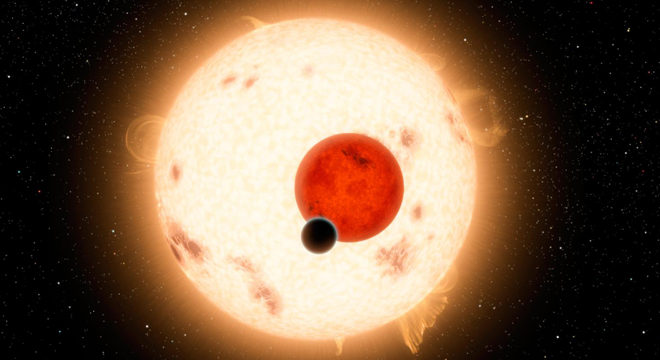NASA has discovered something incredible in our galaxy, but far, far away: a planet orbiting two stars at once, much like Tatooine, Luke Skywalker’s desert homeworld in “Star Wars.”
“This discovery provides confirmation of a new class of planetary systems that could harbor life. Given that most stars in our galaxy are part of a binary system, this means that the opportunities for life are much broader than if planets form only around single stars,” said Kepler principal investigator William Borucki in a news release posted on NASA’s website. “This milestone discovery confirms a theory that scientists have had for decades but could not be proven until now.”
If you could stand on the planet, Kepler 16b, you would see a “dynamic range of sunsets,” according to Laurance Doyle, a participating scientist on the Kepler team and lead author at the SETI Institute. Scroll down for video of the miraculous planet.
“Sometimes the red star would set first, other times the orange star would, sometimes they’d set at the same time,” Doyle continued at a NASA briefing on Thursday at NASA’s Ames Research Center in Moffett Field, Calif. “To tell the time using a sundial you’d need calculus.”
Kepler 16b is an unlikely candidate for life on its surface, though, because it is a cold, dense, gaseous world the size of Saturn, but 50 percent denser and with a core likely rich in heavy metals.
Still, at the news briefing announcing the discovery, special guest John Knoll, a Lucasfilm visual effects supervisor who worked on every “Star Wars” movie going back to “Return of the Jedi,” pointed out that the planet might have moons that could support life.
The fact that the planet exists at all is quite amazing given the fact that the two stars exert gravity perturbations on each other that could throw it out of orbit or destroy it if it were any closer to them. Still it is closer to its stars than we are to the Sun by about 25 percent.
Kepler 16b is on a 229-day, almost perfectly circular orbit around its two stars, both of which are dwarfs and smaller than Earth’s sun.
The larger of the two stars, about 69 percent of the mass of our Sun, is also more orange in color and is at the center of the solar system. The smaller star, about 20 percent the mass of our Sun, is red and orbits the larger.
The entire Kepler 16 system is located in between the constellations Cygnus (The Northern Cross) and Lyra.
NASA found Kepler 16b earlier this year using its Kepler instrument, an orbital telescope launched in 2009 specifically with the goal of finding Earth-like exoplanets, planets outside the solar system. It is currently monitoring 150,000 stars in the same area as Kepler 16.
The discovery was made thanks to the Kepler instrument’s ability to detect “planetary transit,” when the brightness of a star dims as a planet eclipses it.
The Kepler team published its exciting findings in the journal Science and explains more on the NASA wesbite. Watch a video below to learn more about how they turned sci-fi into reality.
And if that wasn’t enough to make you feel the force, consider what astronomer Franck Marchis of the University of California Berkley wrote on his blog Cosmic Diary about the discovery: “This is just a beginning. How this system, which is made of extremely coplanar objects, formed and evolved due to mutual perturbations will definitely get a lot of attention from observers and modelers alike.” Marchis notes that another binary star system, CM Draconis, could also have a large planet orbiting it as well.









